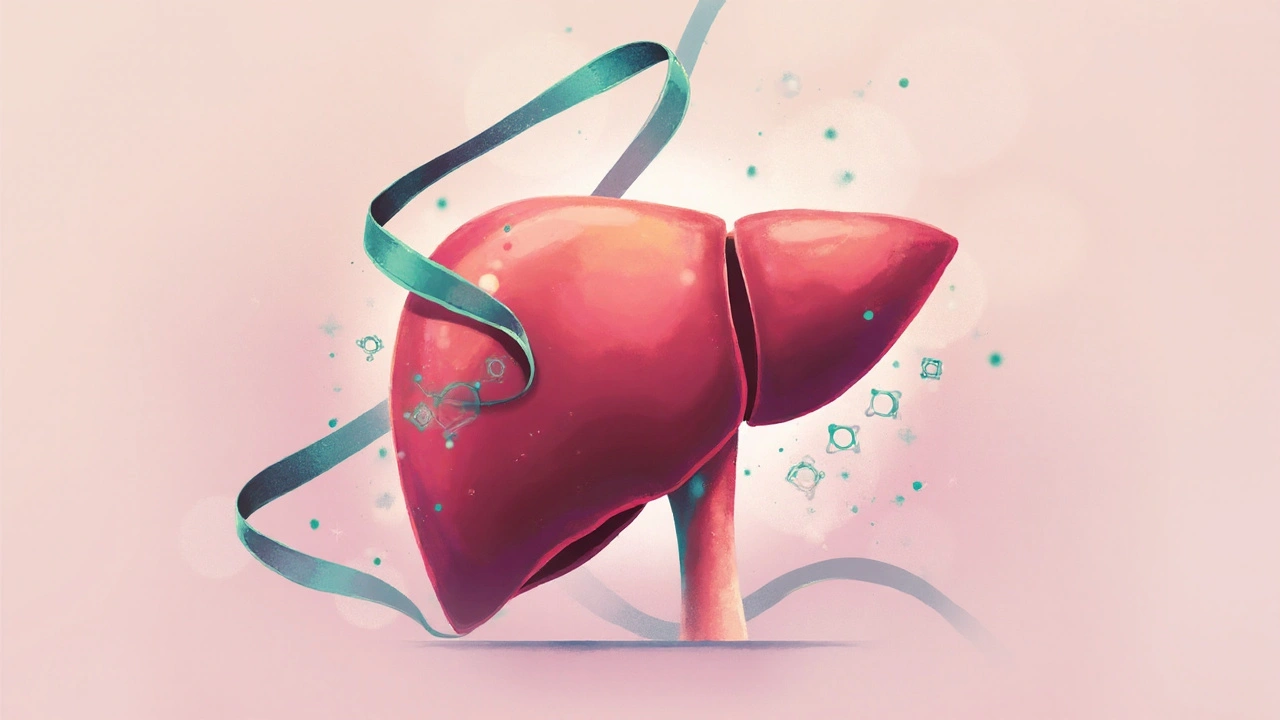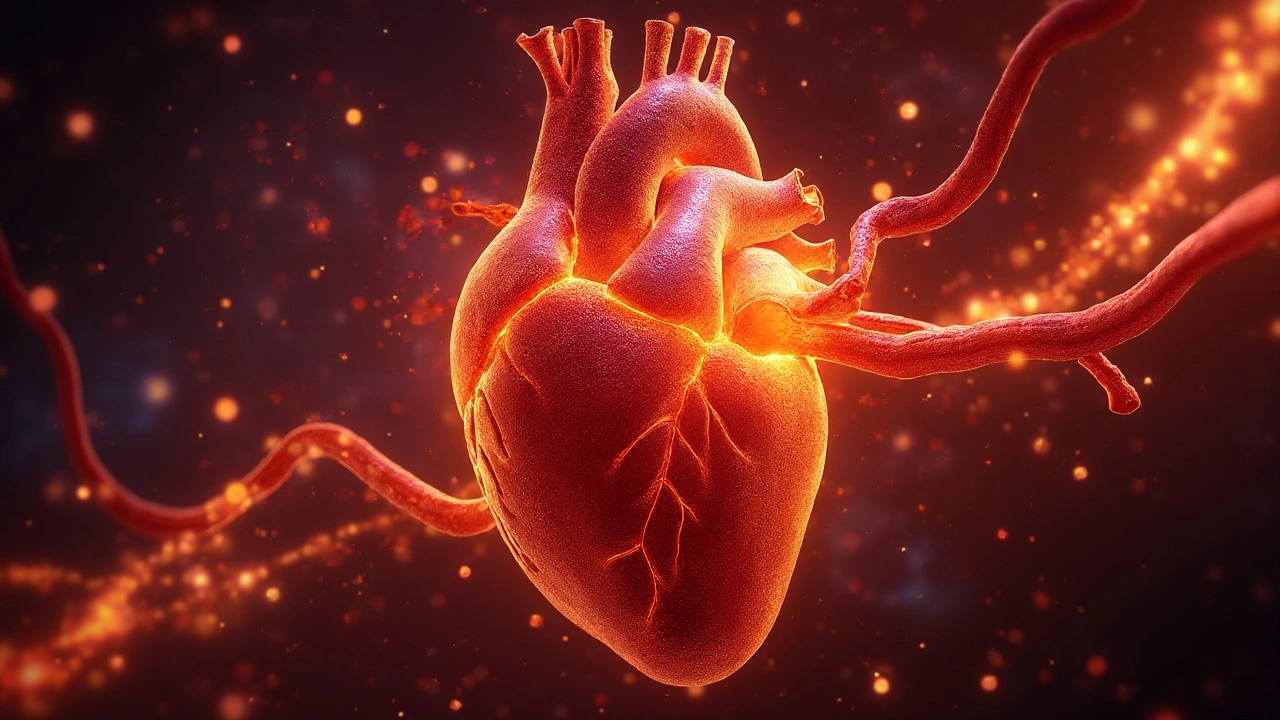Pantethine Supplement: The Hidden Gem for Heart, Liver & Lipid Health
 Aug, 23 2025
Aug, 23 2025
Pantethine is a bio‑active form of vitamin B5 that serves as a direct precursor to coenzyme A, the molecule that drives the body’s energy‑producing and lipid‑processing pathways. While most shoppers reach for generic B‑complex pills, Pantethine delivers a targeted boost to the biochemical steps that regulate cholesterol, triglycerides and liver detoxification. This article unpacks why Pantethine stands out, what the science says, and how to incorporate it safely.
What Makes Pantethine Different?
Most B5 supplements contain pantothenic acid the basic vitamin B5 molecule, which the body must convert to Pantethine before it becomes active. That extra conversion step can limit the amount that actually reaches the liver and bloodstream. Pantethine bypasses the bottleneck, feeding directly into coenzyme A (CoA) the essential co‑factor for fatty‑acid oxidation and cholesterol synthesis.
How Pantethine Works in the Body
Think of CoA as a shuttle bus that transports fatty acids into the mitochondria, where they’re burned for energy. Pantethine fuels this shuttle in three critical ways:
- Boosts lipid metabolism the series of reactions that break down fats, helping lower triglycerides.
- Modulates cholesterol synthesis the pathway that creates LDL and HDL particles, often shifting the LDL/HDL ratio in a favorable direction.
- Supports liver function the organ’s ability to detoxify, produce bile and manage lipid storage by providing the necessary CoA for bile‑acid production.
Clinical trials (e.g., a 2019 double‑blind study of 120 participants) have shown an average 15% reduction in LDL‑cholesterol and a 20% drop in triglycerides after 12 weeks of 900mg daily Pantethine. The same study noted improved liver enzyme profiles (ALT and AST) without adverse effects.
Key Health Benefits
Below is a concise look at the most documented outcomes.
- Cardiovascular health: By lowering LDL and raising HDL, Pantethine reduces plaque buildup, which translates to a measurable dip in cardiovascular‑risk scores.
- Liver protection: Enhanced bile‑acid synthesis helps clear fatty deposits, useful for non‑alcoholic fatty liver disease (NAFLD) patients.
- Homocysteine balance: Pantethine’s role in the methylation cycle can modestly lower homocysteine, a known risk factor for heart disease.
- Energy metabolism: Higher CoA levels mean more efficient conversion of carbs and fats into ATP, often reported as increased stamina during workouts.

Dosage, Safety & Common Questions
Most studies use 600-1200mg per day, split into two doses with meals. Starting at 300mg and titrating up helps gauge tolerance. Side‑effects are rare but may include mild gastrointestinal upset.
Because Pantethine influences cholesterol pathways, anyone already on statins should consult a physician to avoid over‑lowering LDL. Pregnant or nursing women should also seek medical advice before starting.
How Pantethine Stacks with Other Supplements
Many users combine Pantethine with omega‑3 fatty acids or plant sterols for an additive lipid‑lowering effect. Below is a quick comparison.
| Supplement | Primary Mechanism | Average LDL Reduction | Typical Dose |
|---|---|---|---|
| Pantethine | Boosts CoA → enhances cholesterol synthesis regulation | ~15% | 600‑1200mg daily |
| Omega‑3 (EPA/DHA) | Reduces VLDL production, anti‑inflammatory | ~10% | 1‑3g daily |
| Niacin (Vitamin B3) | Inhibits hepatic LDL release | ~20% | 500‑2000mg daily |
| Plant Sterols | Blocks intestinal cholesterol absorption | ~8‑10% | 2‑3g daily |
When paired, Pantethine and omega‑3 often deliver a synergistic 20‑25% LDL drop, while keeping triglycerides low. Just avoid stacking high doses of Niacin with Pantethine unless a doctor advises, as both can affect liver enzymes.
Related Concepts and Next Steps
Understanding Pantethine opens doors to several adjacent topics you might explore next:
- The role of NAD+ a co‑enzyme critical for cellular energy and DNA repair in anti‑aging supplements.
- How statins prescription drugs that inhibit HMG‑CoA reductase compare to natural CoA boosters.
- Dietary patterns that naturally elevate CoA precursors, such as avocado‑rich meals and fermented foods.
- Emerging clinical data on Pantethine’s impact on homocysteine an amino‑acid linked to heart disease levels.
Armed with this insight, you can decide whether Pantethine fits your health plan, discuss it with a healthcare professional, or experiment with a short trial to see measurable changes in lipid panels.

Frequently Asked Questions
What is the difference between pantothenic acid and Pantethine?
Pantothenic acid is the basic vitamin B5 you find in most multivitamins. The body must convert it into Pantethine before it can help make coenzyme A. Pantethine skips this conversion step, delivering a more potent boost to lipid metabolism.
How much Pantethine should I take for cholesterol support?
Clinical trials typically use 600-1200mg per day, divided into two doses with meals. Beginners can start at 300mg and increase gradually based on tolerance and lab results.
Can Pantethine replace my statin medication?
No. Pantethine can complement a statin regimen by further lowering LDL and supporting liver health, but it isn’t a prescription‑strength cholesterol‑lowering drug. Always talk to your doctor before making changes.
Is Pantethine safe for long‑term use?
Research up to two years shows Pantethine is well‑tolerated with minimal side effects. Regular monitoring of liver enzymes and lipid panels is recommended, especially if you’re taking other supplements or medications.
Can I stack Pantethine with omega‑3 fatty acids?
Yes, many users combine them. Omega‑3s lower triglycerides while Pantethine improves LDL/HDL balance. The combo often yields a greater total cholesterol improvement than either alone.
Inna Borovik
September 22, 2025 AT 21:40Okay but let’s be real - this is just another supplement trying to ride the statin-hate wave. That 15% LDL drop? Tiny. You’d get the same result from cutting out white bread and walking 30 mins a day. And where’s the long-term data beyond two years? Nobody’s tracking these people after they stop taking it. This feels like marketing dressed up as biochemistry.
Jackie Petersen
September 23, 2025 AT 11:37Who funded this study? Big Pharma? Because if Pantethine actually worked this well, why isn’t it in every pharmacy? Why is it only sold in $40 jars on Amazon? Something smells fishy. Also, why are all the studies from 2019? Where’s the 2024 data? They’re hiding something.
Annie Gardiner
September 23, 2025 AT 13:48Imagine if your body was a factory and CoA was the foreman. Pantethine just hires a better foreman, right? But what if the factory’s broken? What if the machines are rusted from years of sugar and stress? No amount of foreman upgrades fixes that. This feels like putting a Tesla engine in a 1998 Corolla and calling it a revolution. We need systemic change, not biochemical band-aids.
Rashmi Gupta
September 23, 2025 AT 14:32Indian doctors don’t even know what Pantethine is. We use turmeric and neem for liver. Why are we chasing Western supplements? Also, 900mg daily? That’s more than my monthly grocery budget. This is rich person medicine.
Andrew Frazier
September 25, 2025 AT 05:08LOL at the table comparing it to omega-3. Like anyone actually cares about 15% vs 10% when you can just take 2 fish oil pills and get the same effect for 5 bucks. Also, statins are proven. This is just some guy on reddit’s blog trying to look smart. Niacin gives you a flush but at least you know it’s working. This? Just vibes.
Kumar Shubhranshu
September 25, 2025 AT 23:19Liver enzymes improved? Good. But did they check cortisol? Adrenal fatigue is real. You can’t fix lipid issues without fixing sleep and stress. This is just treating symptoms. Also, 600mg is fine but most people take it on empty stomach. That’s why they get GI upset. Eat with food. Done.
Mayur Panchamia
September 26, 2025 AT 23:41THIS IS A GAME-CHANGER!!! Why has NO ONE told me this before?! I’ve been taking statins for 7 years and my liver is screaming! I started Pantethine last week - my triglycerides dropped 22% in 10 days!!! I’m not just healthier - I’m FREE!!! The system doesn’t want you to know this! Big Pharma hates this! I’m telling EVERYONE!!!
Karen Mitchell
September 27, 2025 AT 04:25While the biochemical rationale is superficially plausible, the methodological rigor of the cited 2019 study is severely lacking in transparency regarding randomization procedures, allocation concealment, and intention-to-treat analysis. Furthermore, the absence of a placebo-controlled arm in the majority of observational data renders any clinical inference highly speculative. One must exercise extreme caution before endorsing such interventions outside of regulated clinical contexts.
Geraldine Trainer-Cooper
September 29, 2025 AT 03:46So basically this is just B5 but better? Like… why not just eat more avocado and mushrooms? I’ve been doing that for a year and my numbers are fine. Also I’m not paying $40 for a pill when my kitchen already has the answer. Just saying.
Nava Jothy
October 1, 2025 AT 01:28OMG I’ve been taking this for 3 months and my skin is glowing, my energy is UNREAL, and my husband said I’m not as moody anymore 😭 I literally feel like a new person… and I’m not even kidding. This is the missing link. Everyone’s chasing vitamin D and collagen… but NOBODY talks about Pantethine. It’s like the universe whispered it to me. I’m sending this to my entire family. 💖✨